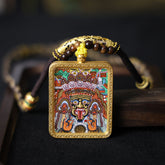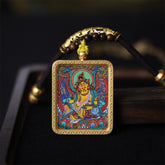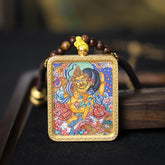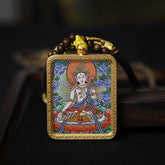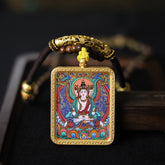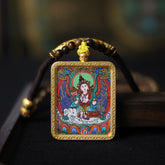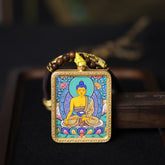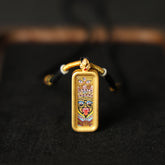What is Thangka? Exploring the Artistic Gem of Tibetan Culture
Hello everyone, I’ve been working in the Thangka industry for nearly a decade. Thangka, an art form with a history of over 1,000 years, is a true treasure in Tibetan culture.
When I first started, someone asked me, “What is Thangka?” I stuttered and couldn’t explain it clearly. I only knew it had exquisite details and beautiful Buddha images. Now, I have some systematic understanding of this art. Today, let’s have a simple chat (because it’s impossible to cover everything in detail) about “What is Thangka”.
1. The Meaning of “Thangka”: A Scroll Painting in Tibetan
“Thangka” is a transliteration of the Tibetan word, also known as Tangka or Thanka. When translated into Chinese, the most accurate term is “scroll painting” — it has a scroll, making it easy to hang for worship and admiration, and also convenient for collection and carrying. Other translations like “cloth painting” or “flat painting” exist, but “scroll painting” is generally considered the most precise.
It’s a one-of-a-kind art form in Tibetan culture, with strong religious overtones and a distinctive artistic style. Otherwise, how could it become a treasure of Chinese ethnic painting art?

△ Tibet Thangka

△scroll painting
2. Thangka Materials: “Diverse and Precious” — Embroidery Can Make Your Eyes Sore
Thangka materials are quite “exquisite” and “diverse”:
- Commonly, they’re painted on cloth, silk, silk satin, or paper, then mounted with silk.
- Some are embroidered on silk or brocade, with stitches as fine as hair — landscapes, figures, flowers, pavilions, and towers can all be embroidered.
- More rarely, there are kesi (silk tapestry), appliqué, and even pearl Thangkas (yes, you read that right — pearls!).
By the way, any Thangka related to Buddhism must be blessed by lamas after mounting.

△ Embroidered thangka
3. Thangka Painting: Artists Are “Detail-Oriented Perfectionists” — Paintings Hundreds of Years Old Still Look New
It’s no exaggeration to say Thangka painting is complex. The most common subjects include Buddhas, Bodhisattvas, and patriarchs of various sects. But you’ll also find Tibetan history, astronomy, geography, Tibetan medicine, and even historical figures on them.
The materials are extremely sophisticated. All pigments are natural minerals or plant-based, so they’re bright and long-lasting — even after hundreds or thousands of years, the paintings still look golden and magnificent.
Thangka artists are total “detail freaks” and “perfectionists”. Every line and every expression must follow religious rituals. The finest lines can only be seen clearly with a magnifying glass — you have to admire their skill!
4. Thangka User Classification: It’s Not Just for “Worship”
Don’t think Thangka is just a “decoration” in temples. There are many categories by purpose:
- Practice Thangka: A “companion” for believers, used for visualization and worship during spiritual practice.
- Solemn Thangka: Painted by lay believers themselves or by artists, then offered to temple halls — it’s like “decorating” a hall for the Buddha.
- Dharma Propagation Thangka: The most lively type! Displayed in markets or in front of temples, lamas or laypeople will sing or recite stories to educate people.
Common themes include the life of the Buddha, the biography of Padmasambhava, and Amitabha’s Pure Land.
5. Thangka Sizes: From “Palm-Sized” to “Dozens of Meters Long” — Nothing Is Impossible
There are no strict size restrictions for Thangkas. Giant Thangkas can be dozens of meters long (just imagine the Shoton Festival in Lhasa — that’s truly amazing!). Small ones are only palm-sized, easy to put in your pocket, and many people use them as amulets.
Shapes also matter: The most common is a vertical long strip. Horizontal ones are rare, and square ones are mostly seen in Mandala (Tantric altar) Thangkas.

By now, you probably have a general idea of what Thangka is. It’s not just art — it’s a “living fossil” of Tibetan culture, an “auxiliary tool” for Buddhist practice, and a carrier of plateau customs and beliefs. If you have questions, feel free to comment or send a private message — I’ll try my best to answer.
Wishing you all good luck and happiness. Tashi Delek!
Editor’s Picks
Zaki Ram Thangka Necklace, Daily Series
- $199.00 USD
$234.00 USD- $199.00 USD
- Unit price
- / per
Yellow Jambhala Thangka Necklace, Daily Series
- $199.00 USD
$234.00 USD- $199.00 USD
- Unit price
- / per
Yellow Jambhala Thangka Necklace - Master Series
- $599.00 USD
$704.00 USD- $599.00 USD
- Unit price
- / per
White Tara Thangka Necklace-Master Series
- $699.00 USD
$822.00 USD- $699.00 USD
- Unit price
- / per
Vairocana Buddha Thangka Necklace, Daily Series
- $199.00 USD
$234.00 USD- $199.00 USD
- Unit price
- / per
Six-Armed Mahakala Thangka Necklace, Daily Series
- $199.00 USD
$234.00 USD- $199.00 USD
- Unit price
- / per
Samantabhadra Bodhisattva Thangka Necklace, Daily Series
- $199.00 USD
$234.00 USD- $199.00 USD
- Unit price
- / per
Sakyamuni Buddha Thangka Necklace, Master Series
- $599.00 USD
$704.00 USD- $599.00 USD
- Unit price
- / per

